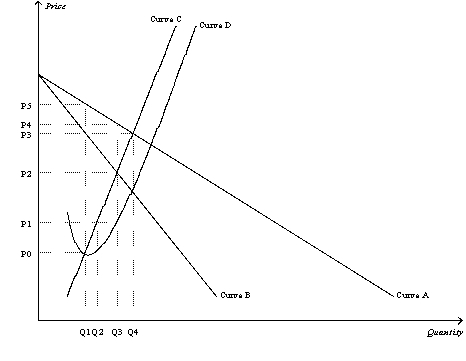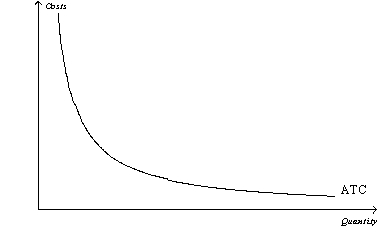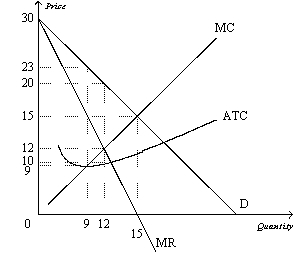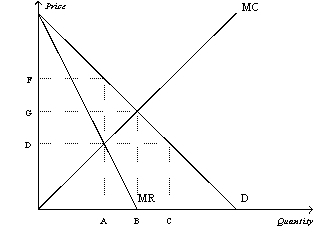A) $14
B) $40
C) $112
D) $164
Correct Answer

verified
Correct Answer
verified
Multiple Choice
A monopolist can sell 200 units of output for $36 per unit.Alternatively,it can sell 201 units of output for $35.80 per unit.The marginal revenue of the 201ˢᵗ unit of output is
A) $-4.20.
B) $-0.20.
C) $4.20.
D) $35.80.
Correct Answer

verified
Correct Answer
verified
Multiple Choice
Granting a pharmaceutical company a patent for a new medicine will lead to (i) a product that is priced higher than it would be without the exclusive rights. (ii) incentives for pharmaceutical companies to invest in research and development. (iii) higher quantities of output than without the patent.
A) (i) and (ii) only
B) (ii) and (iii) only
C) (i) and (iii) only
D) (i) , (ii) , and (iii)
Correct Answer

verified
Correct Answer
verified
Multiple Choice
Figure 15-4
 -Refer to Figure 15-4.Profit on a typical unit sold for a profit-maximizing monopoly would equal
-Refer to Figure 15-4.Profit on a typical unit sold for a profit-maximizing monopoly would equal
A) P5-P0.
B) P4-P2.
C) P4-P1.
D) P4-P3.
Correct Answer

verified
Correct Answer
verified
Multiple Choice
Price discrimination is the business practice of
A) bundling related products to increase total sales.
B) selling the same good at different prices to different customers.
C) pricing above marginal cost.
D) hiring marketing experts to increase consumers' brand loyalty.
Correct Answer

verified
Correct Answer
verified
Multiple Choice
Figure 15-1
 -Refer to Figure 15-1.The shape of the average total cost curve reveals information about the nature of the barrier to entry that might exist in a monopoly market.Which of the following monopoly types best coincides with the figure?
-Refer to Figure 15-1.The shape of the average total cost curve reveals information about the nature of the barrier to entry that might exist in a monopoly market.Which of the following monopoly types best coincides with the figure?
A) ownership of a key resource by a single firm
B) natural monopoly
C) government-created monopoly
D) a patent or copyright monopoly
Correct Answer

verified
Correct Answer
verified
Multiple Choice
Table 15-5
A monopolist faces the following demand curve:
 -Refer to Table 15-5.The monopolist has total fixed costs of $60 and has a constant marginal cost of $15.What is the profit-maximizing price?
-Refer to Table 15-5.The monopolist has total fixed costs of $60 and has a constant marginal cost of $15.What is the profit-maximizing price?
A) $4
B) $39
C) $36
D) $42
Correct Answer

verified
Correct Answer
verified
Multiple Choice
Table 15-2
Tanya has the following demand curve for selling taffy. Assume that Tanya has a marginal cost of $3 per unit.
 -Refer to Table 15-2.What is Tanya's profit-maximizing level of output?
-Refer to Table 15-2.What is Tanya's profit-maximizing level of output?
A) 1
B) 2
C) 3
D) 4
Correct Answer

verified
Correct Answer
verified
True/False
A monopolist does not have a supply curve because the firm's decision about how much to supply is impossible to separate from the demand curve it faces.
Correct Answer

verified
Correct Answer
verified
True/False
Price discrimination can increase both the monopolist's profits and society's welfare.
Correct Answer

verified
Correct Answer
verified
Multiple Choice
For a monopoly,the socially efficient level of output occurs where
A) marginal revenue equals marginal cost.
B) average revenue equals marginal cost.
C) marginal revenue equals average total cost.
D) average revenue equals average total cost.
Correct Answer

verified
Correct Answer
verified
Multiple Choice
Reduced competition through merging of companies will raise social welfare
A) if the social cost from the synergies exceeds the benefit of increased market power.
B) if the benefit from the synergies exceeds the social cost of increased market power.
C) always.
D) never.
Correct Answer

verified
Correct Answer
verified
Multiple Choice
Figure 15-6
 -Refer to Figure 15-6.In order to maximize profits,the monopolist should produce
-Refer to Figure 15-6.In order to maximize profits,the monopolist should produce
A) 9 units.
B) 12 units.
C) 15 units.
D) more than 15 units.
Correct Answer

verified
Correct Answer
verified
Multiple Choice
Splitting up a monopoly is often justified on the grounds that
A) consumers prefer dealing with small firms.
B) small firms have lower costs.
C) competition is inherently efficient.
D) small firms produce higher quality products.
Correct Answer

verified
Correct Answer
verified
Multiple Choice
Which of the following statements is correct?
A) Public ownership is preferred to regulation in order to minimize the deadweight losses associated with natural monopolies.
B) Antitrust laws are always the best way to limit monopoly power.
C) It is possible that the best approach to monopolies is for the government to do nothing.
D) Marginal-cost pricing requires a natural monopoly to earn zero economic profits.
Correct Answer

verified
Correct Answer
verified
Multiple Choice
A monopolist will choose to increase output when
A) market price increases.
B) at all levels of output, marginal cost increases.
C) at the present level of output, marginal revenue exceeds marginal cost.
D) the demand curve shifts to the left.
Correct Answer

verified
Correct Answer
verified
Multiple Choice
One method used to control the ability of firms to capture monopoly profit in the United States is through
A) government purchase of products produced by monopolists.
B) government distribution of a monopolist's excess production.
C) enforcement of antitrust laws.
D) regulation of firms in highly competitive markets.
Correct Answer

verified
Correct Answer
verified
Multiple Choice
Which of the following statements comparing monopoly with competition is correct?
A) A monopolist produces a higher level of output and charges a lower price than a competitive firm would.
B) With perfect price discrimination, the total surplus under monopoly can be the same as under competition.
C) With or without price discrimination, the consumer surplus under monopoly is at least as large as it would be under competition.
D) The deadweight loss associated with monopoly is caused by the positive economic profits of the monopolist; competitive firms do not earn a positive economic profit so there is no deadweight loss under competition.
Correct Answer

verified
Correct Answer
verified
Multiple Choice
Figure 15-7
 -Refer to Figure 15-7.What is the monopoly price and quantity?
-Refer to Figure 15-7.What is the monopoly price and quantity?
A) price = F; quantity = A
B) price = G; quantity = B
C) price = G; quantity = A
D) price = D; quantity = A
Correct Answer

verified
Correct Answer
verified
Multiple Choice
Antitrust laws
A) prevent firms from maximizing profits.
B) allow the government to prevent mergers, even ones that would benefit consumers.
C) require the government to measure both the benefits and costs of a potential merger.
D) All of the above are correct.
Correct Answer

verified
Correct Answer
verified
Showing 61 - 80 of 526
Related Exams